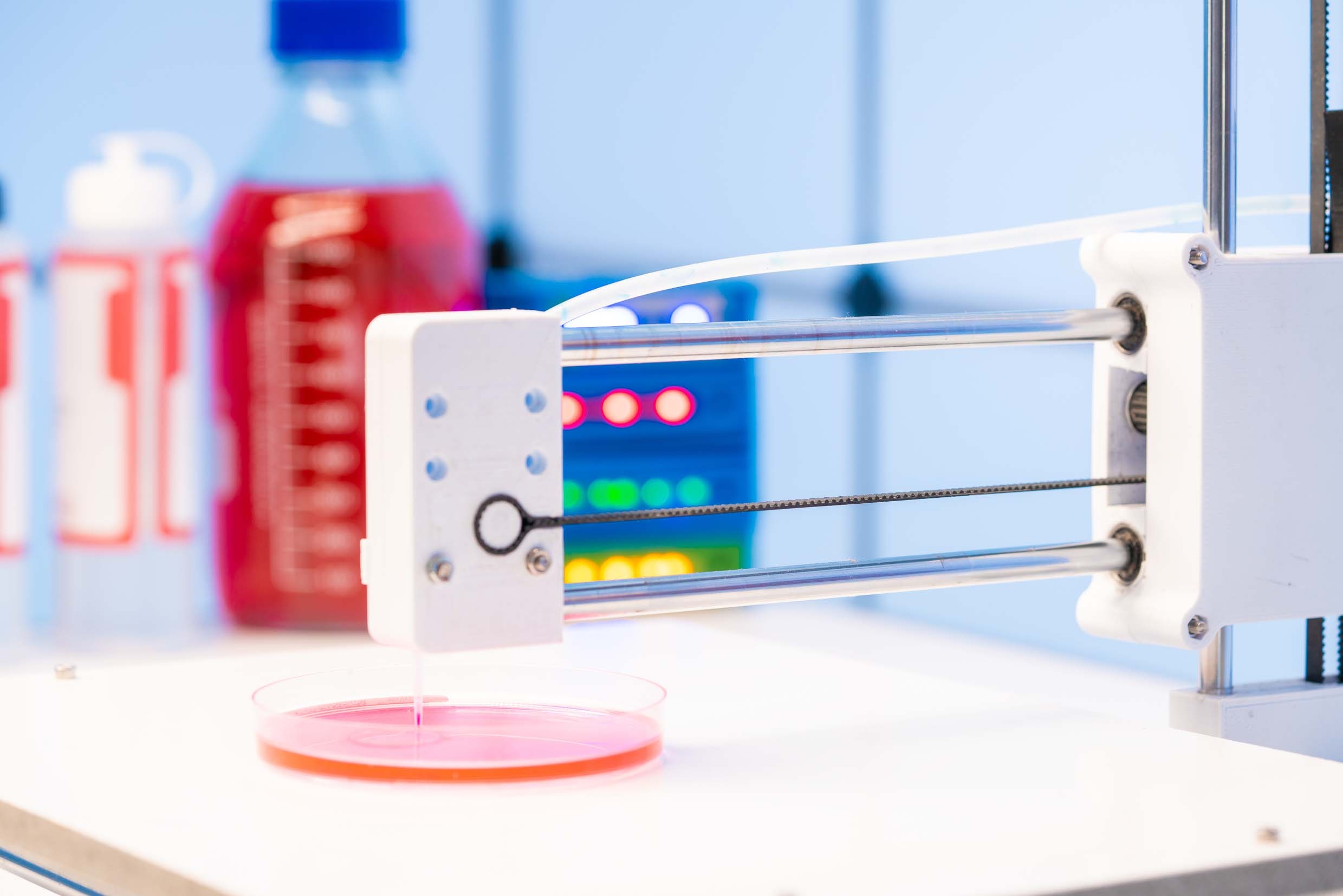
Biomaterials For 3D Printing
Designing biomaterials for 3D printing, also known as
additive manufacturing, is a fast developing topic with enormous potential in
biomedical applications. 3D printing can be used with a variety of
biomaterials, including polymers, hydrogels, ceramics, composites, and metals.
The technology used to print a biomaterial determines its printability.
There are various 3D printing techniques for biomaterials,
including inkjet printing, stereolithography, fused deposition modelling, laser
printing, extrusion printing, and others. These techniques allow the
construction of intricate 3D structures layer by layer, with high resolution
and precision. Significant progress has been made in various 3D printing
technologies, including laser printing, stereolithography, extrusion printing,
fused disposition printing, and inkjet printing.
3D printing has found applications in creating
patient-specific implants, scaffolds for regenerative medicine and tissue
engineering, dental molds, craniofacial implants, prosthetic parts, surgical
models, organ printing, and tissue models for drug discovery. It is also being
used in the development of smart wound dressings loaded with various materials
(antibiotics, antibacterial drugs, nanoparticles) that can help accelerate the
wound healing rate.
Despite the progress, the field still faces challenges in
processing these materials into self-supporting devices with tunable mechanics,
degradation, and bioactivity. However, the future of 3D printing in
biomaterials looks promising, with potentially profound impacts on the medical
field.
Recent clinical applications of 3D-printed biomaterials
3D printing is being used to produce complex biomedical
devices according to computer design using patient-specific anatomical data.
This includes patient-specific implants, scaffolds for tissue engineering,
diagnostic platforms, and drug delivery systems. 3D printing has evolved to
create one-of-a-kind devices, implants, and scaffolds for tissue engineering,
diagnostic platforms, and drug delivery systems. It is being used to produce
complex biomedical devices according to computer design using patient-specific
anatomical data.
3D printing is used in combination with stem cells for
personalized regenerative medicine. This approach could potentially be utilised
for the regeneration of complex tissues and organs. There is renewed interest
in combining stem cells with custom 3D scaffolds for personalized regenerative
medicine. This approach could potentially be used for the regeneration of
complex tissues (e.g., bone, cartilage, muscles, vessels, nerves in the
craniomaxillofacial complex), and complex organs with intricate 3D microarchitecture
(e.g., liver, lymphoid organs).
3D printing technology is being used in the development of
smart wound dressings loaded with various materials (antibiotics, antibacterial
drugs, nanoparticles) that can help accelerate the wound healing rate. 3D
printing technology is being used in the development of smart wound dressings
loaded with various materials (antibiotics, antibacterial drugs, nanoparticles)
that can help accelerate the wound healing rate. Hydrogels, which are
biocompatible, non-toxic materials, have been widely used in wound healing.
In clinical settings, 3D printing of biodegradable metals is
mainly used in orthopaedics and stomatology. 3D-printed patient-specific
osteotomy instruments, orthopaedic implants, and dental implants have been
approved for clinical use.
There have been recent developments in the 3D printing of biodegradable
metals for orthopaedic purposes. These metals are often used to provide support
for hard tissue and prevent complications.
These are just a few examples. The field is rapidly
evolving, and new applications are being developed regularly. However, it’s
important to note that while these applications show great promise, there are
still several technological limitations that need to be addressed before 3D
printing can be used routinely for complex tissue and organ regeneration.
Risks associated with 3D-printed implants
Due to the mechanical mismatch between metallic implants and
bone, there is a risk of stress shielding which could result in bone resorption
and implant failure. Although 3D printing allows for high precision, any errors
in the digital model can result in implants that do not fit perfectly. This can
lead to discomfort, misalignment, and even implant failure.
There are also ethical and regulatory issues associated with
3D bioprinting in medicine. For instance, there are concerns related to
experimental testing on humans, irreversibility, loss of treatment opportunity,
and replicability.
To enhance patient acceptance and engagement with
personalized 3D-printed therapeutic interventions, effective patient education
is essential. Clear and comprehensive communication about the benefits,
limitations, and potential risks associated with 3D printing should be provided
to patients.
These risks highlight the importance of careful design,
rigorous testing, and clear communication in the development and application of
3D-printed implants.
Bibliography
Liang, W., Zhou, C.,
Zhang, H. et al. Recent advances in 3D printing of
biodegradable metals for orthopaedic applications. J Biol
Eng 17, 56 (2023). https://doi.org/10.1186/s13036-023-00371-7
Gilbert, F., O’Connell, C.D., Mladenovska, T. et al.
Print Me an Organ? Ethical and Regulatory Issues Emerging from 3D Bioprinting
in Medicine. Sci Eng Ethics 24, 73–91 (2018). https://doi.org/10.1007/s11948-017-9874-6
Alzoubi, L., Aljabali, A.A.A. & Tambuwala, M.M.
Empowering Precision Medicine: The Impact of 3D Printing on Personalized
Therapeutic. AAPS PharmSciTech 24, 228 (2023). https://doi.org/10.1208/s12249-023-02682-w
Bhatti, S.S., Singh, J. 3D printing of biomaterials
for biomedical applications: a review. Int J Interact Des Manuf (2023). https://doi.org/10.1007/s12008-023-01525-z
Tappa, K.; Jammalamadaka, U. Novel Biomaterials Used
in Medical 3D Printing Techniques. J. Funct. Biomater. 2018, 9, 17. https://doi.org/10.3390/jfb9010017
S S, R G AP, Bajaj G, et al. A review on the recent
applications of synthetic biopolymers in 3D printing for biomedical
applications. J Mater Sci Mater Med. 2023;34(12):62. Published 2023 Nov 20.
doi:10.1007/s10856-023-06765-9
Chia, H.N., Wu, B.M.
Recent advances in 3D printing of biomaterials. J Biol Eng 9,
4 (2015). https://doi.org/10.1186/s13036-015-0001-4
Choudary, R., Saini, N.,
Chopra, D.S. et al. A comprehensive review
of 3D bioprinting biomaterials: Properties, strategies and wound healing
application. Journal of Materials Research 38, 3264–3300 (2023). https://doi.org/10.1557/s43578-023-01078-7
Bhatti, S.S., Singh, J.
3D printing of biomaterials for biomedical applications: a review. Int J
Interact Des Manuf (2023). https://doi.org/10.1007/s12008-023-01525-z
Choudary, R., Saini,
N., Chopra, D.S. et al. A comprehensive review of 3D bioprinting biomaterials:
Properties, strategies and wound healing application. Journal
of Materials Research 38, 3264–3300 (2023). https://doi.org/10.1557/s43578-023-01078-7
Guvendiren, M., Molde,
J., Soares, R. M. D., & Kohn, J. (2016). Designing Biomaterials for 3D
Printing. ACS Biomaterials Science and Engineering, 2(10), 1679-1693. https://doi.org/10.1021/acsbiomaterials.6b00121
Atala, A.,
Introduction: 3D Printing for Biomaterials, Chemical Reviews 2020 120 (19),
10545-10546,